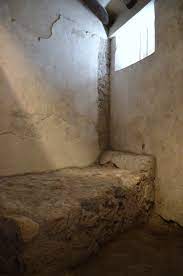In 79 AD, when Mount Vesuvius erupted in the city of Pompeii in the Roman Empire in modern-day Italy, the ferocity of its eruption spared no one, neither rich nor poor. A recently excavated ‘slave room’ has shed more light on the lives of enslaved people in the city and the Roman Empire. The two millennia-old room is said to have very likely housed a family of three people whose daily work included looking after their master’s horses and ceremonial chariot, the remains of which were also found nearby.
According to the Italian Ministry of Culture, the discovery has enriched the modern world’s knowledge about the daily lives of the people of ancient Pompeii and the Roman Empire, especially the class of society about which very little is still known viz., the enslaved people.
Archaeologists discovered the 172-square-foot room while surveying a villa known as Civita Giuliana which is located just north of the ancient city’s walls. They found three beds made of ropes and planks, ceramic jugs, and a chamber pot that was used as a toilet. There was just a small window in the room that allowed light into the room. Many other findings have also propounded the belief that the room was also used for storage. The archaeologists have also excavated a chariot shaft and a wooden chest that contained objects that could have been used for the horses’ harnesses.
The archaeologists had made similar finds previously at Civita Giuliana. Since 2017, they have found a traditional chariot and a stable with the remnants of three yoked horses. This proved that Civita Giuliana had belonged to someone wealthy during the period of the eruption. For the archaeologists who had explored the site, the slave room constituted an exceptional discovery. According to the director of Pompeii’s archaeological park, the room offered a rare glimpse into the difficult lives of the people who very rarely appeared in historical accounts of the site which were for the most part written by men belonging to the elite, thus rendering the people of the lower classes invisible.
Though slaves didn’t come up in many stories regarding ancient Rome, they were commonly found throughout the Roman Empire. They were considered no more than property by their owners who could beat, brand, and even kill them without facing any retribution for their actions. The majority of the enslaved people during this period were foreigners, who were mostly prisoners of war or captured sailors, or those who had been bought and sold beyond Roman territory. Occasionally, they were the children of Romans who had been sold for money.
Both slaves and free people who lived in the city of Pompeii met with the same fate on August 24 in 79 AD, when the nearby Mount Vesuvius erupted and pounded the city which then had a population of around 13,000, with lava, volcanic ash, and stones of pumice. Pliny the Younger, a prominent Roman historian wrote that the people of Pompeii who didn’t have any other defense against the shower of stones, covered themselves with pillows to protect themselves when the eruption occurred. It caused a dark cloud that was charged with inflammable matter to suddenly fall on the city. According to Pliny the Younger, some people of Pompeii lamented their fate while others prayed that they would die.
When the eruption stopped and the ash cooled, Pompeii became a graveyard as around 2,000 people died in the city and a total of about 16,000 people in total are thought to have died in the eruption of Mount Vesuvius. Today, Pompeii looks as if it is frozen in time as the ash from the eruption after cooling preserved bodies, artwork, and rooms similar to the one discovered in Civita Giuliana. All the preserved remnants tell something about how life and death were like in the destroyed city.
The slave room is a very exceptional and remarkable discovery in that sense as according to the archaeologists working on it, it is the most significant find for them even though it does not contain things that can be considered as treasures. According to the archeologists, the true treasures in Pompeii were the knowledge about the experiences of human beings, especially like the ones in the slave room who were very vulnerable in the society of their time and to whom the slave room is distinctive testimony. Though the room may not look like a lot, it represents a small piece of the much larger mosaic of the history of the Roman Empire and offers a look at what life was like for slaves in the Roman Empire including the fallen city of Pompeii.
The slave room may not look like much. But it represents a small piece of the much larger history of the Roman Empire. What’s more, it offers an enticing, though sad look at what life was like for Roman slaves in the doomed city of Pompeii.
